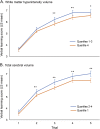Subclinical cerebrovascular disease inversely associates with learning ability: The NOMAS
- PMID: 26002489
- PMCID: PMC4464740
- DOI: 10.1212/WNL.0000000000001657
Subclinical cerebrovascular disease inversely associates with learning ability: The NOMAS
Abstract
Objective: Memory has been examined in subjects with imaging markers of cerebrovascular disease, but learning has been less well studied. We examined the relationship among subclinical cerebrovascular disease, cerebral volumes, and verbal learning in an ethnically and racially diverse community sample.
Methods: A clinically stroke-free subset of Northern Manhattan Study participants underwent cognitive testing and brain MRI with quantification of white matter hyperintensity volume (WMHV) and total cerebral volume (TCV) using semiautomated segmentation. We used generalized linear regression and mixed models to examine the association between imaging findings and verbal learning.
Results: There were 1,272 participants (61% women, mean age 70 ± 9 years). Participants with greater WMHV and smaller TCV remembered fewer total words on a list-learning task (β = -0.83 per SD change in WMHV, 95% confidence interval [CI] = -1.22 to -0.45, p < 0.0001; and β = 0.48 per SD change in TCV, 95% CI = 0.05 to 0.90, p = 0.03, respectively). Subclinical brain infarction (SBI) was not associated with total words learned (β = -0.04, 95% CI = -1.08 to 1.00, p = 0.94). Those with greater WMHV had increased odds of a flatter learning slope. After excluding participants with SBI, the association between total words learned and WMHV remained significant. All measurements were adjusted for age, education, race/ethnicity, medical insurance status, and the presence of SBI.
Conclusions: White matter hyperintensities, a marker of cerebral small vessel disease, may have an impact on learning slope. This suggests that verbal learning performance can be incorporated into neuropsychological measures for vascular cognitive impairment and that cerebrovascular disease discovered on imaging affects the ability to learn new information.
© 2015 American Academy of Neurology.
Figures

Comment in
-
Cerebrovascular disease: Subclinical cerebrovascular disease can impede learning.Nat Rev Neurol. 2015 Jul;11(7):370. doi: 10.1038/nrneurol.2015.101. Epub 2015 Jun 9. Nat Rev Neurol. 2015. PMID: 26055467 No abstract available.
Similar articles
-
Cognitive correlates of white matter lesion load and brain atrophy: the Northern Manhattan Study.Neurology. 2015 Aug 4;85(5):441-9. doi: 10.1212/WNL.0000000000001716. Epub 2015 Jul 8. Neurology. 2015. PMID: 26156514 Free PMC article.
-
LA volumes and reservoir function are associated with subclinical cerebrovascular disease: the CABL (Cardiovascular Abnormalities and Brain Lesions) study.JACC Cardiovasc Imaging. 2013 Mar;6(3):313-23. doi: 10.1016/j.jcmg.2012.10.019. JACC Cardiovasc Imaging. 2013. PMID: 23473112 Free PMC article.
-
Fibroblast Growth Factor 23 Is Associated With Subclinical Cerebrovascular Damage: The Northern Manhattan Study.Stroke. 2016 Apr;47(4):923-8. doi: 10.1161/STROKEAHA.115.012379. Epub 2016 Mar 8. Stroke. 2016. PMID: 26956260 Free PMC article.
-
Cerebral white matter disease and functional decline in older adults from the Northern Manhattan Study: A longitudinal cohort study.PLoS Med. 2018 Mar 20;15(3):e1002529. doi: 10.1371/journal.pmed.1002529. eCollection 2018 Mar. PLoS Med. 2018. PMID: 29558467 Free PMC article.
-
Association of serum soluble receptor for advanced glycation end-products with subclinical cerebrovascular disease: the Northern Manhattan Study (NOMAS).Atherosclerosis. 2011 May;216(1):192-8. doi: 10.1016/j.atherosclerosis.2011.01.024. Epub 2011 Jan 21. Atherosclerosis. 2011. PMID: 21316677 Free PMC article.
Cited by
-
Functional Trajectories, Cognition, and Subclinical Cerebrovascular Disease.Stroke. 2018 Mar;49(3):549-555. doi: 10.1161/STROKEAHA.117.019595. Epub 2018 Jan 26. Stroke. 2018. PMID: 29374104 Free PMC article. Clinical Trial.
-
Cerebrovascular disease: Subclinical cerebrovascular disease can impede learning.Nat Rev Neurol. 2015 Jul;11(7):370. doi: 10.1038/nrneurol.2015.101. Epub 2015 Jun 9. Nat Rev Neurol. 2015. PMID: 26055467 No abstract available.
-
Silent brain infarctions and cognition decline: systematic review and meta-analysis.J Neurol. 2020 Feb;267(2):502-512. doi: 10.1007/s00415-019-09534-3. Epub 2019 Nov 5. J Neurol. 2020. PMID: 31691021
-
Association of estimated pulse wave velocity with cognitive function in a multiethnic diverse population: The Northern Manhattan Study.Alzheimers Dement. 2024 Jul;20(7):4903-4913. doi: 10.1002/alz.14064. Epub 2024 Jun 19. Alzheimers Dement. 2024. PMID: 38895994 Free PMC article.
-
Characterization of White Matter Hyperintensities in Large-Scale MRI-Studies.Front Neurol. 2019 Mar 26;10:238. doi: 10.3389/fneur.2019.00238. eCollection 2019. Front Neurol. 2019. PMID: 30972001 Free PMC article.
References
-
- Wright CB, Zonderman AB. What can memory tests predict about the aging brain? The freedom to recall. Neurology 2013;80:1274–1275. - PubMed
-
- Prins ND, van Dijk EJ, den Heijer T, et al. Cerebral small-vessel disease and decline in information processing speed, executive function and memory. Brain 2005;128:2034–2041. - PubMed
-
- de Groot JC, de Leeuw F, Oudkerk M, Van Gijn J. Cerebral white matter lesions and cognitive function: the Rotterdam Scan Study. Ann Neurol 2000;47:145–151. - PubMed
-
- Vermeer SE, Prins ND, Den Heijer T, Hofman A, Koudstaal PJ, Breteler MMB. Silent brain infarcts and the risk of dementia and cognitive decline. N Engl J Med 2003;348:1215–1222. - PubMed
